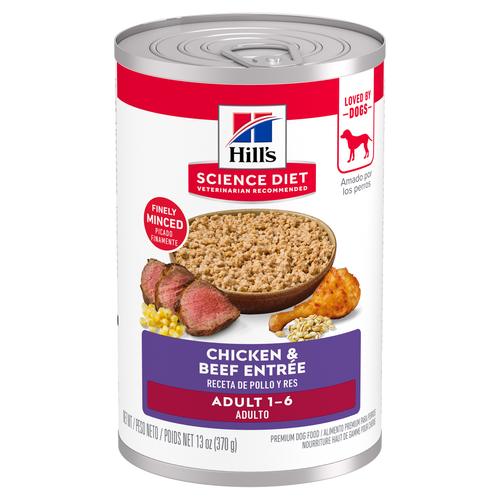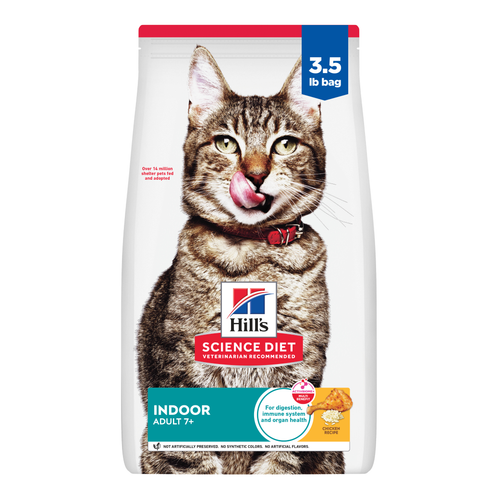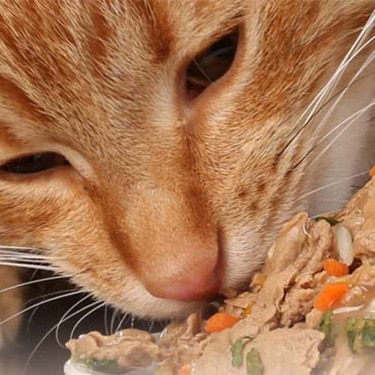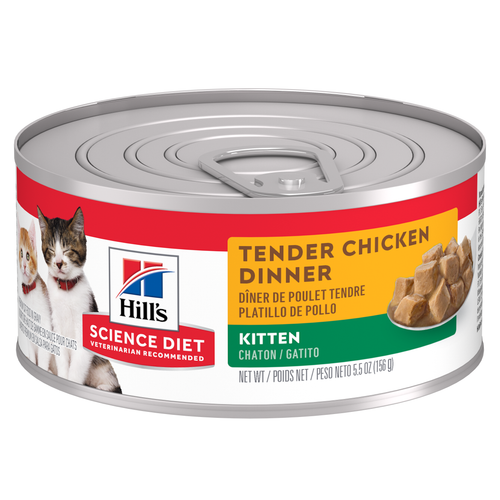
-
Find the right food for your petTake this quiz to see which food may be the best for your furry friend.Find the right food for your petTake this quiz to see which food may be the best for your furry friend.Featured products
 Adult Large Breed Chicken & Barley Recipe Dog Food
Adult Large Breed Chicken & Barley Recipe Dog FoodSupports healthy joints, lean muscle, and beautiful coat for large breed dogs
Shop Now Adult Chicken & Barley Recipe Dog Food
Adult Chicken & Barley Recipe Dog FoodSupports lean muscle and beautiful coat for adult dogs
Shop Now Hill's Science Diet Adult Chicken & Beef Entrée Dog Food
Hill's Science Diet Adult Chicken & Beef Entrée Dog FoodChicken & Beef Entrée in a delicious loaf with complete & balanced nutrition to help keep adult dogs active and healthy
Shop NowFeatured products Senior Vitality Adult 7+ Tuna & Vegetables Stew
Senior Vitality Adult 7+ Tuna & Vegetables StewImproves Everyday Ability to Get Up & Go
Shop Now Adult Turkey & Liver Entrée Cat Food
Adult Turkey & Liver Entrée Cat FoodPrecisely balanced nutrition with the delicious taste of minced turkey & liver to help fuel the energy needs of cats during the prime of their life
Shop Now Adult 7+ Indoor Chicken Recipe Cat Food
Adult 7+ Indoor Chicken Recipe Cat FoodSupports energy level and beautiful fur in mature indoor cats
Shop Now -
Dog
- Dog Tips & Articles
-
Health Category
- Weight
- Food & Environmental Sensitivities
- Urinary
- Digestive
- Joint
- Kidney
-
Life Stage
- Puppy Nutrition
- Adult Nutrition
- Senior Nutrition
Cat- Cat Tips & Articles
-
Health Category
- Weight
- Skin & Food Sensitivities
- Urinary
- Digestive
- Kidney
-
Life Stage
- Kitten Nutrition
- Adult Nutrition
Featured articles What Is Littermate Syndrome? Pet Adoption Guide
What Is Littermate Syndrome? Pet Adoption GuideLearn more about littermate syndrome in dogs and cats and how to successfully navigate adoption and early socialization processes.
Read More How to Properly Mix Wet & Dry Pet Foods
How to Properly Mix Wet & Dry Pet FoodsAn Orange cat eating from a bowl filled with mixed food
Read More The Science Behind Our Love for Pets
The Science Behind Our Love for PetsLearn the scientific reasons why we have such strong connections with our pets, and what science says about the love between humans and our furry friends.
Read More -


Cat ingrown nails are rarely a problem in the wild because the friction of climbing trees works as a natural nail file for cats. Inside your home, however, our domesticated felines are more likely to need some grooming assistance. Curious if this is a problem with your cat? Take a look — what you're looking for is the cat claw growing into the pad of the foot.
When a cat's nails become overgrown and very long, the tip can grow around and into the cat's nail pad, resulting in a cat ingrown nail. This differs from a human's ingrown nail because the ingrown cat nail is actually growing out and back around into their paw pad, raising the pain factor significantly. Read on to learn more about spotting a cat claw growing into the pad and what you can do to help your kitty.
The Cause of Your Cat's Ingrown Nail
If you've ever seen your cat raised on their hind limbs, scratching furiously with their front paws, you may have wondered what causes them to do this. This natural habit is a behavior that sharpens the cat's nails and prevents them from overgrowing. In the wild, or with proper access to scratching posts and other nail-filing toys, ingrown nails generally don't occur or cause problems.
Among domesticated cats, however, an overgrowth of cat nails is a common problem, according to Merck Veterinary Manual. If your cat's nails are left untrimmed, and your cat does not have access to scratching posts, your cat's claws are at risk of curling around as they grow into and eventually puncture the paw pads.
How to Spot a Cat's Ingrown Nail
This is one condition that can be diagnosed by simply examining your cat's paw pads. The average pet parent can clearly identify a curved nail that makes contact with the paw pad itself. Before the claw damages the paw pad, you may notice your cat's nails getting caught on blankets or carpets more easily because the nails can no longer fully retract. Hearing a tapping sound as the cat walks on hard surfaces is another tell-tale sign. Intermittent bleeding and limping might also be observed because each step further damages the paw pad. Because of the pain associated with movement, affected cats may seem more lethargic or might lick or bite at their feet.

A common complication with ingrown claws is an infection of the injured paw pad. Discharge from the paw pad may also occur alongside an infection and can range from somewhat transparent yellow to thick yellow-green. The nails of cats are a site where bacteria and fungus become trapped and accumulate. While this usually doesn't pose a risk to cats, once the outer layer of the paw pad is punctured, the area is ripe for an infection.


Tasty Tips
Noticing a Cat Claw Growing Into the Pad?
If you do notice that your cat has one or more nails growing into their paw pads, you will want to schedule a veterinary visit as soon as possible to address this painful condition. Each excruciating step causes further injury to the paw pads to the point where long-term damage can occur.
Your veterinarian will need to heavily sedate or anesthetize your cat to initiate treatment. This step is necessary because removing a cat ingrown nail from the paw pad is intensely painful. While clipping the nail is normally a relatively simple process, your vet will have to maneuver with extra finesse to prevent further damage to the paw. The vet will then flush the wound in the paw pad with a surgical disinfectant that is safe for living tissue. Depending on the depth and severity of the resulting wound, the surrounding paw pad tissue may need to be surgically cut away and sutured shut.
All in all, the procedure is quick and relatively simple. You and your cat may be sent home with antibiotics as well as pain medication based on the severity of the injury. Bandages on the paws and a kitty cone collar around the head to prevent paw chewing may also be necessary, and recovery time is most often around one to two weeks. With veterinary intervention, the outlook for a cat ingrown nail is great. Routine nail trimming should be maintained to prevent the nail overgrowth and paw pad injury from recurring. If you are not comfortable trimming your cat's nails yourself, your veterinarian will be happy to help.
The good news is that a cat ingrown nail is entirely preventable. While it's easiest to train your cat to tolerate nail trims from the early kitten stages, this is one at-home grooming necessity that is worth the time and patience it takes to master.
Remember, routine feline mani-pedi time is not for vanity's sake — it's an important step in the prevention of overgrown nails to make sure your feline continues to have a happy and healthy pampered life.


Dr. Laci Schaible is a small animal veterinarian, veterinary journalist, and a thought leader in the industry. She received her Doctor of Veterinary Medicine from Texas A&M University and her Masters in Legal Studies from Wake Forest University.
Related products

Improves Everyday Ability to Get Up & Go

Precisely balanced nutrition with the delicious taste of minced turkey & liver to help fuel the energy needs of cats during the prime of their life

Supports energy level and beautiful fur in mature indoor cats

Delectable chunks with tender chicken smothered in a rich gravy
Related articles

When you adopt a cat, you don't just gain a best friend; you also save her life. Here's why getting a cat from a local animal shelter makes so much sense.

Discover how to train your cat, starting with very basic first steps that both reward good behavior and discourage the bad.

Discover which cat toys games your feline friend might like, and how they are great sources of exercise. Explore our library of articles to learn more.

Learn how to litter train a kitten with this guide to potty training, including when to start litter training kittens and troubleshooting tips.

Put your cat on a diet without them knowing
Our low calorie formula helps you control your cat's weight. It's packed with high-quality protein for building lean muscles, and made with purposeful ingredients for a flavorful, nutritious meal. Clinically proven antioxidants, Vitamin C+E, help promote a healthy immune system.
Put your cat on a diet without them knowing
Our low calorie formula helps you control your cat's weight. It's packed with high-quality protein for building lean muscles, and made with purposeful ingredients for a flavorful, nutritious meal. Clinically proven antioxidants, Vitamin C+E, help promote a healthy immune system.

